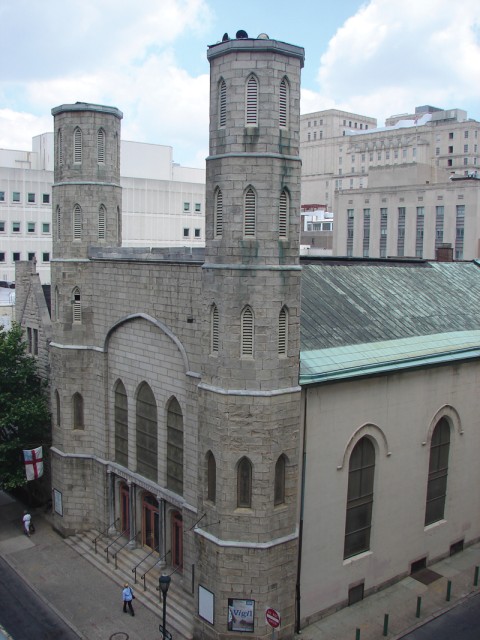New life in old space at St. Stephen’s, Philadelphia
I knew Sunday worship wasn’t viable. But what about weekdays?

Some months after I was ordained as an Episcopal priest at the age of 70, I was recommended to be vicar of a historic church in the center of Philadelphia—a church that had been closed for a year after a long time on life support and which for years prior to its closing had an ever-dwindling congregation numbering in the low double digits. The bishop had a hunch that this church could become something and asked me to try to make it something, whatever that would turn out to be. Of course, there was no instruction sheet, no set of directions.
I became a step-sitter for a while. I sat on the church steps and tried to read the environment and take the pulse of the neighborhood. It was not an accident that the first person I spoke with almost every day was a neighborhood man who was battling all kinds of demons, including addiction. (Almost three years later, having gotten to know him well, I am helping him navigate a stem-cell transplant.)
Read our latest issue or browse back issues.
Sitting on the steps was a wonderful way to see and be seen. I quickly learned that the neighborhood known as the Tenth Street corridor was busy with pedestrians, cars, trucks, and emergency vehicles, especially Monday through Friday. St. Stephen’s, built in 1823, is in the middle of a block on Tenth Street surrounded by the offices, academic buildings, hospitals, and clinics of a major urban university and medical center. Right next to the church is a methadone clinic. In the vicinity are small restaurants, pharmacies, parking garages, alleys, and the seen and unseen indigent and poor, many of whom have no other place to go.
My informal research revealed that almost everybody in the neighborhood on any given day was there for work except the people in most need, for whom the neighborhood was home. I wondered: What if we opened the church as a place of comfort and quiet? And what if we welcomed everyone in the spirit of Matthew 25: “I was a stranger and you welcomed me”?
The church reopened on Ash Wednesday 2017. We did not yet have a website or a social media presence, so we made flyers and used email as best we could to let people know that we would offer ashes and a blessing from 7:30 a.m. to 5:30 p.m. Using a number clicker—an old-school aid—we counted 175 people who came through St. Stephen’s that day. Throughout the day, I heard people say again and again, “I walked by the church so many times and it was never open. Now that I am in it, I see how beautiful and peaceful it is. Thank you for opening it.”
That experience led me to believe that the best way St. Stephen’s could serve the neighborhood was to be open on weekdays and offer a daily Eucharist in the middle of the day. We began that ministry the very next day.
It was quickly clear to me that launching Sunday worship was not viable. Why would people in the neighborhood be attracted to Sunday activities at a church that was in recovery? And why would people who were in the neighborhood only from Monday to Friday for their jobs decide to return to the neighborhood on Sunday morning?
Samuel Wells has described ministry as “creating the right spaces and letting the Holy Spirit do the rest.” That’s a perfect description of what we have tried to do at St. Stephen’s: create an intimate, serene, and sacred place of dailiness. The sanctuary is open six to eight hours on weekdays with a Eucharist at 12:15 p.m. For our celebration of the Eucharist, we follow the Episcopal lectionary in A Great Cloud of Witnesses, an account of prophetic witnesses of all kinds. We provide copies of each holy person’s biography as well as a copy of the readings. I take five minutes to talk about these holy women and men and what their lives and their witness could mean for us now.
Remembering the comments I heard on that first Ash Wednesday, I knew we needed to use social media to present ourselves to the community. Gradually, we have become known. At the same time, knowing that most of the residents of the neighborhood do not own computers or cell phones, we created external signage and changed the message daily.
We have used our new website to present the uniqueness of St. Stephen’s in words and pictures. Our social media expert convinced me that people would also want to know who I was, so I started writing a blog. Not surprisingly, I learned more about St. Stephen’s by writing about it. With the help of a gifted part-time art historian and archival expert, we were able to identify superb archival materials to use on the website. The aim was to let people know our own history.
Part of what makes St. Stephen’s the right space is that it is a place of mysterious beauty, serenity, and intimacy. From the first time I came into the building, I thought that with the proper revitalization and care it had the kind of space that could lead to an encounter with the sacred. It has an unusual set of stained-glass windows, imaginative lighting, marvelous natural acoustics, and beautiful red wooden chairs. It is the kind of space where one can let “the Holy Spirit do the rest.”
The flexibility of the space allows us to offer many different kinds of arts programs, including musical performances, poetry readings, and drama. We’ve had lectures and short-term educational programs presented by people from the medical school. We’ve hosted groups like the local Preservation Alliance, which talked about our work in refurbishing the building. We’ve presented weekly choral evensong services and larger liturgical celebrations on behalf of the diocese. Two long-term tenants had remained at the church even during the period it was closed, one a theater company, the other an orchestra program for middle school and high school students. While the rent revenue from both tenants is not substantial, the groups are important parts of our public face and our place in the arts community.
We struggled, however, with how to serve residents of the neighborhood, especially those without any regular shelter. We decided that work had in some way to be part of our mission. So we started serving coffee and snacks weekdays and soon had up to 70 people coming to the building every day. Eventually we provided sleeping mats so those who were without shelter the previous night could come into the church, have something to eat and drink, and then take a nap in the quiet of the sanctuary. That our sanctuary was our only real public space seemed providential: it was safe, enveloping, quiet, and palpably sacred.
In older churches especially it is important to join past, present, and future and to help people appreciate the full arc of the congregation’s history. In 2004 St. Stephen’s had decided to sell a white marble piece it owned created by the great American sculptor Augustus Saint-Gaudens. It had been made in the 1890s at the request of a church member, Silas Weir Mitchell, as a memorial to Mitchell’s daughter. The work, titled The Angel of Purity, was sold to the Philadelphia Museum of Art. Early on I discovered that money from the sale had been put into a fund designed to maintain the church and its remaining art works, including the enormously valuable windows. Given the size of the fund, it was something of a mystery that the church was in such a state of disrepair.
As we started drawing on the fund, one of our tasks was to inspect the floor of the church, and that is how we discovered a situation that radically changed our understanding of St. Stephen’s. Documents in the archives showed that the church’s later transept and parish house were built directly over the original church burial ground. When we lifted the subfloor to inspect the pine floor of the transept, we discovered tomb slabs that had been covered over at least twice.
On another drawing in the archives we identified nine burial vaults. When we opened up the floor, we found all nine vaults, just where the archival drawing said they would be.
We decided to display all the vaults in the new floor and to transform the old transept into a commemorative space called the burial cloister. This was a powerful way to give the nine families and their stories new life. The past was brought back to the present and past and present were physically, symbolically, and ritually reintegrated. This new/old commemorative space asserts that we embrace our St. Stephen’s community without barriers, including the barrier of time.
If there is a model of church renewal here, it is grounded in giving new life to what is old. We have found new life in an old place.
This sense of place, I have discovered, has a great deal to do with why I became a priest. Recently, someone asked me why I became a priest, and knowing that mine was a nontraditional path to ordination—beginning with my age—I tried very hard to offer a simple and heartfelt answer. I said that I became a priest because I want to do good and to do good work in the context of sacramental ministry, and that it was sacramental ministry to which I believed I was called.
More specifically, I said that I want to care for souls, and I believe that everyone has a soul, though not everyone knows how to respond to the yearnings of the soul, whether in prayer or another way. For me, caring for souls is about praying, and praying is about listening. Long ago, I made one of poet Anne Sexton’s exhortations my own: “Put your ear down close to your soul and listen hard.” For me, listening is the art of caring for the souls I serve.
At St. Stephen’s, I have learned how to listen also to a very old and sacred place, and that has made it much easier to give the place new life. Maybe this new life was that something the bishop had in mind.
A version of this article appears in the print edition under the title “Listening to a place.”





